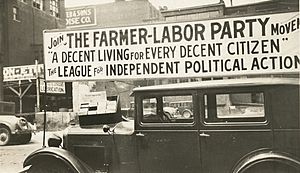Minnesota Farmer–Labor Party facts for kids
Quick facts for kids
Farmer–Labor Party of Minnesota
|
|
|---|---|
 |
|
| Founded | 1918 |
| Dissolved | 1944 |
| Preceded by | Nonpartisan League |
| Succeeded by | Minnesota Democratic–Farmer–Labor Party |
| Ideology | Populism Progressivism Cooperative economics |
| Political position | Left-wing |
| National affiliation | Labor Party of the United States (1919–20) Farmer–Labor Party of the United States (1920–23; 1924–36) Federated Farmer–Labor Party (1923–24) None (1918–19; 1936–44) |
The Minnesota Farmer–Labor Party (FL) was a political party in Minnesota, United States, that existed from 1918 to 1944. This party was very important in Minnesota politics, especially during the Great Depression. It was one of the most successful "third parties" in American history at the state level. It was also the longest-lasting part of the national Farmer–Labor movement.
At its strongest in the 1920s and 1930s, the party had many important members. These included three Minnesota governors, four United States senators, and eight United States representatives. They even held most of the seats in the Minnesota Legislature. In 1944, Hubert Humphrey and Elmer Benson helped the party join with Minnesota's Democratic Party. This created the Minnesota Democratic–Farmer–Labor Party that exists today.
Contents
History of the Farmer–Labor Party
The Minnesota Farmer–Labor Party started from groups like the Nonpartisan League in North Dakota and the Union Labor Party in Duluth, Minnesota. Their main ideas were to protect farmers and labor unions. They also supported the government owning some industries and creating social security laws to help people.
In 1936, the party worked closely with President Franklin Roosevelt's New Deal coalition. They supported his reelection because his plans helped many Americans during tough times.
One big challenge for the party was bringing together different groups. Farmers in rural areas and workers in cities often had different needs. However, they shared a common belief that they were hardworking people being treated unfairly by a small, powerful group. Farmers wanted help with taxes, loans, and fair prices for their crops. City workers, on the other hand, needed help with unemployment, like public works jobs or financial aid. The party worked hard to unite these different groups under one banner.
In 1944, the Minnesota Democratic Party, led by Hubert Humphrey, joined with the Farmer–Labor Party. This merger happened on April 15, 1944, creating the Minnesota Democratic–Farmer–Labor Party.
Important Leaders and Elected Officials
Key Politicians Elected from the Party
Many important politicians were part of the Farmer–Labor Party. Here are some of them:
- Governors of Minnesota:
- Floyd B. Olson (1931–1936)
- Hjalmar Petersen (1936–1937)
- Elmer Austin Benson (1937–1939)
- United States Senators from Minnesota:
- Henrik Shipstead (1923–1941); he later became a Republican
- Magnus Johnson (1923–1925)
- Elmer Austin Benson (1935–1937)
- Ernest Lundeen (1937–1940)
- United States Representatives from Minnesota:
- William Leighton Carss (1919–1921, 1925–1929)
- Ole J. Kvale (1923–1929)
- Knud Wefald (1923–1927)
- Paul John Kvale (1929–1939)
- Henry M. Arens (1933–1935)
- Magnus Johnson (1933–1935)
- Ernest Lundeen (1933–1937); he also served as a Republican Representative and later in the Senate
- Francis Shoemaker (1933–1935)
- John T. Bernard (1937-1939)
- Minnesota State Legislators:
- Samuel H. Bellman (1935-1938)
- John W. Cox (1935-1938)
Images for kids




